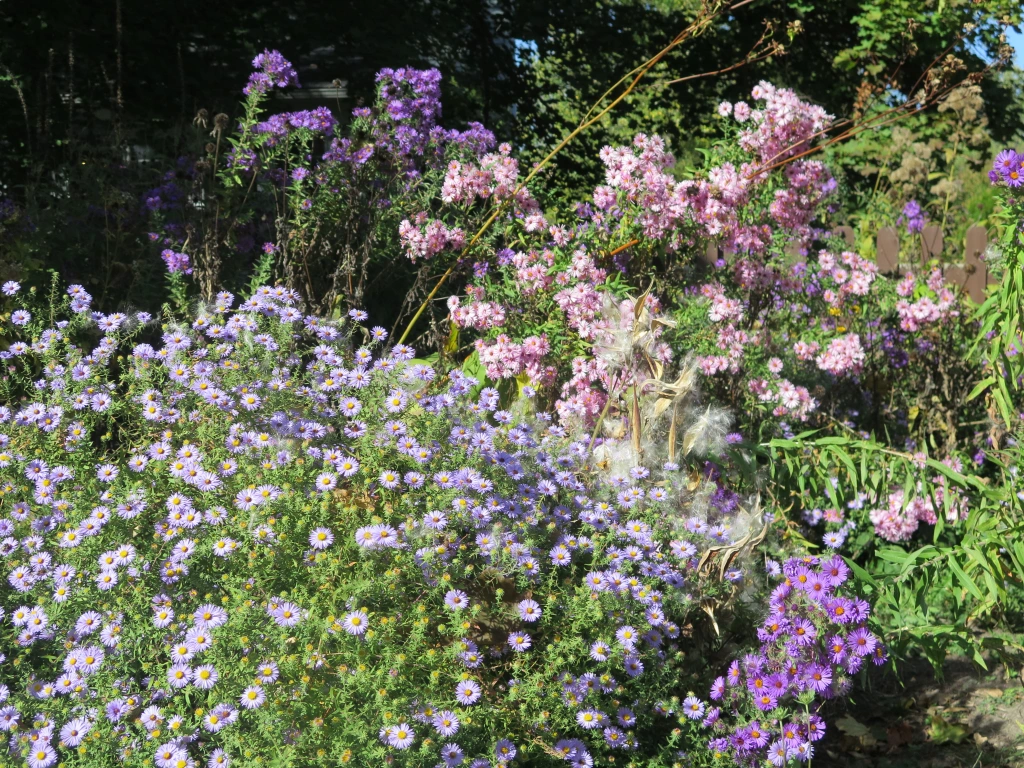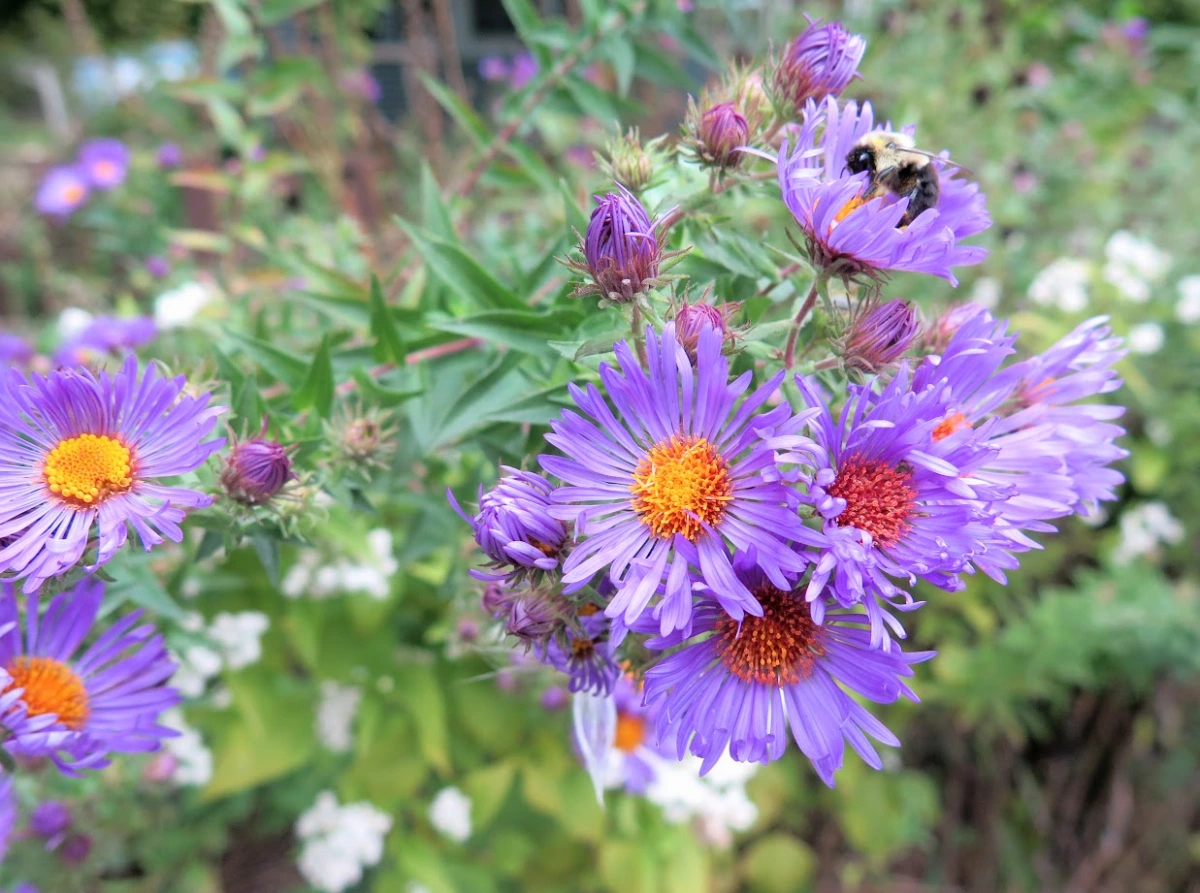All year long in the garden, I have stood on the deck, looked out, and thought, “Hmm, I need more flowers.” This is what I always think, and it’s as true now as ever. More New England aster! It seems like it only makes sense to have purple stretching back as far as the eye can see -all the way to the back of my backyard. So I’ve begun taking notes where I will move transplants next spring. Luckily, New England asters divide easily and readily self seed in my garden, and each year there are plenty of new plants to move around.

New England Aster (Symphyotrichum novae-angliae) is one of the last blooming flowers in the fall, filling the garden with lovely, bountiful, purple flowers. The flowers attract many, many pollinators, from the last monarchs passing through, to so many different kinds of bees.
Beyond feeding multitudes of pollinators, asters in general, are what Doug Tallamy, author of Bringing Nature Home, refers to as “keystone plants.” Asters are known to be host plants for 112 species of moths and butterflies -that’s a lot of caterpillars eating asters! They are definitely a species you, your family, many bees, butterflies, moths, bugs, and birds can all enjoy having in the garden.
A Big Floppy Plant/How to Prune New England Asters
New England asters have an interesting growth form… Ok, the truth is, if left to their own devices, they often get a bit lanky and scraggly and flop over, and then they frequently lose the leaves from the bottom half of the plant, which looks totally crazy! But really, all this can be worked with! And New England asters are worth it, just wonderful, big, purple plants that buzz with life in the fall.

One way some gardeners like to deal with scraggly New England asters is to cut them back. For plants that are a few years old and doing well, cutting them back results in shorter, bushier plants with more branching, less flopping, and often more flowers. After some research, it seems like the best method is to prune them twice, as described on Pat Sutton’s Wildlife Garden. Once near Memorial day and then again near July 4th.
The memorial day cut should be about ½ to ⅔ the length of the plant, or 1 to 2 feet from the top. The second July 4th cut isn’t as extreme, but just cutting back some of the new growth that resulted from the first cut. In fact, the second cut can prune selectively (for example cutting the front of the plant shorter than the back of the plant) to influence the eventual height of the blooms. (Make sure to leave the clippings under the plant so any caterpillars on those stems can climb back on the plant.)
On some plants, ones that might have stayed a bit shorter, you can even skip the second cut, and those plants will likely bloom earlier than the plants pruned twice. And like this, you can extend the bloom time of New England aster. Imagine: a garden with un-pruned, once pruned and twice pruned plants. I wonder how much that would extend the bloom time? I’m going to try this next year, and I’ll let you know.

If you do not have time or energy for cutting back asters on holiday weekends, I understand. All the same, an un-pruned aster can be a great plant at the back of a border (my crazy un-pruned plants often reach six foot plus), and it can intermix well with short and tall species, in a more meadow-like garden. It does great when grown behind or mixed with a stalwart plant that can hide its stem and lend it a bit of support.
E Pluribus Unum
With asters, what we think of as the flower, is actually made up of many, many tiny flowers, which is why they are sometimes referred to as the composite family. The edge of the inflorescence is made up of “ray” flowers, which, in this case, carry the purple petals (one petal per ray flower), and interior “disc” flowers, which are tiny tubular flowers, in the disc-like center. In New England aster, these little disc flowers open from the outside in, and they look like little cups, holding the nectar that so many pollinators come to drink.

At first, New England aster, with its sometimes scrappy demeanor, might not strike a gardener as particularly delicate. But something especially beautiful happens with this flower: they close their flowers at night, and open them again in the morning. I don’t know why, but I love flowers that open and close.
Although it’s not a subject that has been studied much, the prevailing thought is that plants that close their flowers at night (and on cold and rainy days) are protecting their pollen from moisture. In some species, uncontrolled rehydration of pollen grains, from dew or rain, ultimately reduces the viability of the pollen, so you gotta keep that pollen dry!
Peace in the Garden
I learned a lot trying, and mostly failing, to get my camera to capture a flower closing, but perhaps the most important thing I learned is how peaceful it can be to just watch videos of evening flowers and bumblebees. Have you heard of Slow TV? Where Norwegians just have a TV show of a train ride in real time, or people knitting a sweater in real time. Very peaceful. But I think they might want to add a slow flower program. This could be the first episode. Watching a bumblebee fall asleep and sleep in a New England aster flower. (If bumblebee bees are out and about at bedtime, they’ll often just find a nice flower to sleep on.) This little bee stretches and gets comfortable on the far left of the plant, the breeze rocks him to sleep, the crickets sing, and all the other little sleepy flower activity goes on.
Do you have New England asters? A favorite pruning technique?
Resources
Asteraceae/Compositae (Aster Family), Ohio Plants
Why Do Flowers in Namaqualand Close? Flower closure in relation to the environment and pollen sensitivity to moisture, by Amrei Von Hase
Bringing Nature Home, by Doug Tallamy

12 replies on “New England Aster: The Ins and The Outs!”
I have had New England asters for years, but hated the floppiness. This year I severely pruned one clump to see if that would cause me to rethink removing them all together. I pruned them to about 30″, cutting off the top 10-12″ of plant. Wow–they were lovely this year, much fuller and no flopping! Next year they will all get pruned.
LikeLike
That is great! Do you recall when you pruned them?
LikeLike
Thanks for your post! I too have New England Asters in my garden, the final and most prolific bloomers in late October. I love them.
LikeLike
I agree! They can be such beautiful shades of purple!
LikeLike
I’ve pruned them in June for a bushier plant but discovered by accident that when they lie on the ground, a row of blooms comes from the stem. Now I weight them down with a small rock and get a carpet of blooms in the front with taller blooms in the back.
LikeLike
Oh! That is a great tip, thank you! I’ll try that next year!
LikeLike
I planted three kinds of asters in my garden this spring and none came up – New England, Sky Blue and Aromatic. What to do?
LikeLike
Hey Sara! Hmm… That’s so strange. no sign whatsoever?! Well, I guess the main one I really surprised to not see is the aromatic aster, (New England aster needs a cold treatment) but I would just advise to start again. Generally, I really prefer to start things in trays and plant them out, because I haven’t had a lot of success directly sowing seeds into the garden. When the plants do it, it works, when I do it, not so much. I wonder how many seeds did you put out? Is it possible they might have been eaten by birds, etc?
LikeLike
Is it ok to trim them in the first year?
LikeLike
Generally, I would let them go unpruned the first year, so they can really send a lot of energy towards establishing a strong root system. Thanks for the question!
LikeLike
Thank you so much for this article. I plan to add asters to my garden next year, both for their beauty but also for the seeds for the birds and and because they are host plants.
LikeLike
Definitely, was just thinking this morning how much I love a blousy flopped over aster!
LikeLike